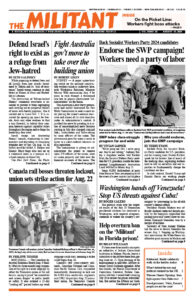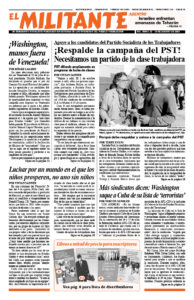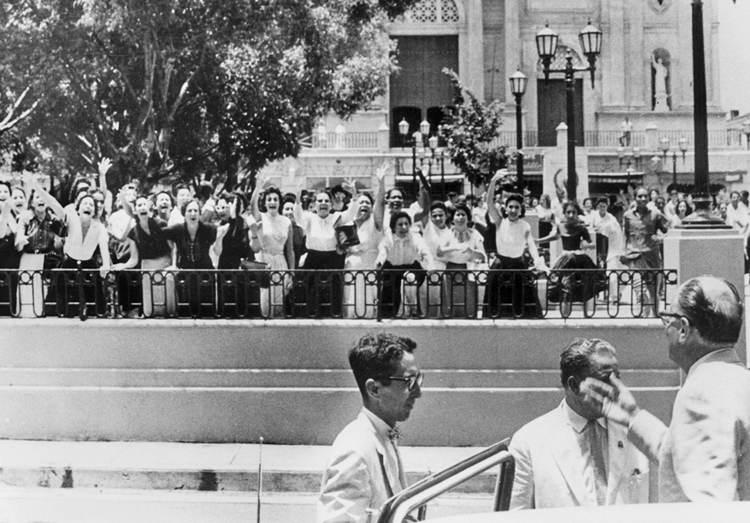To help mark the anniversary of July 26, 1953, the opening of the Cuban Revolution, one of Pathfinder’s Books of the Month for August is Women in Cuba: The Making of a Revolution Within the Revolution — From Santiago de Cuba and the Rebel Army, to the Birth of the Federation of Cuban Women. It is by Vilma Espín, Asela de los Santos and Yolanda Ferrer, three leaders of the Federation of Cuban Women. It traces the unprecedented integration of women into the ranks and leadership of the social revolution that deepened with the popular triumph in 1959 against the U.S.-backed dictatorship. The excerpt is from the chapter “It gave us a sense of worth,” an interview with de los Santos led by Mary-Alice Waters, the book’s editor. Copyright © 2012 by Pathfinder Press. Reprinted by permission.
When Fidel [Castro] left prison in May 1955, freed by the strength of the amnesty campaign, he tried to remain in Havana and organize a revolutionary civic movement to create by legal means the conditions to overthrow Batista. That wasn’t possible. The military set out to hunt down Fidel and kill him.
Fidel tried to communicate through the media, the radio. He tried to inform people, to tell them the truth about the situation. The regime responded by shutting down radio stations, television stations, and newspapers. And by pursuing Fidel.
While still in Havana, Fidel organized the group that would become the national leadership of the movement. Revolutionaries from several groups came together. They decided to call the new organization the July 26 Revolutionary Movement.
Fidel and the other compañeros went to Mexico to prepare what became the Granma expedition. Those who stayed behind were responsible for revolutionary work in Cuba.
In 1956 we would either be free or be martyrs, as Fidel put it. That’s what all of us thought. …
[The July 26 Movement] was formed in June 1955, after the amnesty. History Will Absolve Me, Fidel’s defense speech at the Moncada trial, had been published, and supporters made sure it made its way all over the island. Fidel transformed himself from accused to accuser. From that moment on, I was won to the cause for good.
I began to work in the July 26 Movement alongside Vilma, alongside Frank [País], and alongside Haydée Santamaría and Armando Hart. The two of them had come to Santiago at the request of the movement’s national leadership to strengthen the work there. …
On November 30, 1956, beginning at 7:00 a.m., we carried out an armed action in Santiago de Cuba in support of the Granma landing, which we thought was going to be the same day. (They ended up landing two days later.) Combatants stopped cars in Santiago and told drivers that their cars were being taken over on behalf of the movement. We had no other means of transportation. Combatants took to the streets, in uniforms with armbands, chanting, “Down with Batista!” and “Long live Fidel!”
The fighting lasted until ten or eleven in the morning — Vilma describes it well in her account. Three combatants were killed, Pepito Tey, Otto Parellada, and Tony Alomá. But several of the mission’s objectives had been achieved. When the insurrectional forces retreated, the army began to emerge from the barracks, where they had been holed up.
No one was arrested on the day of the action in Santiago itself, since the people protected us. People opened the doors to their houses. …
The people knew what had been done to the Moncada combatants could happen again. It still fills me with emotion to talk about it. I’m not telling you something I heard from others. I lived through it.
To me it seemed something unheard of — people not yet involved in the movement protecting youth who had gone out in the streets ready to die, ready to sacrifice their lives. …
I never went underground. Vilma did. Her house was the headquarters, and Batista’s forces raided it and began to hunt for her. So she went underground. But this being Santiago, the authorities never could get her. People protected her and she managed to escape. We always tried to choose houses with more than one way to get out, including by rooftop if need be. …
Cuban women have a tradition of struggle, from the mambises in the nineteenth century wars of independence to today. That tradition is an important political element in our socialist revolution.
With a historical leap, we find ourselves in 1953, the beginning of the struggle for genuine independence — I’m referring here to the attack on Moncada — and the heroic examples of Melba Hernández and Haydée Santamaría, who participated in that action.
As the struggle continued, more and more women became part of it.
Fidel’s course of building a mass revolutionary movement capable of sustaining and supporting the armed struggle enabled both men and women to be integrated.
Women joined the ranks of the Rebel Army. In the Sierra Maestra there was a platoon of women fighters known as the Marianas, named after Mariana Grajales, the mother of the eight Maceo brothers, all of whom fought for independence from Spain. She was one of the great heroes of the war for independence.
In the underground we did whatever was necessary. We sewed uniforms and armbands for the Rebel Army. We helped provide cover for moving weapons and young combatants. We found families who would house revolutionary fighters who had gone underground. We secured medicine. We served as messengers between different revolutionary fronts. We distributed subversive propaganda and collected supplies.
In short, women worked on every front in the underground struggle. …
As the struggle deepened, women saw greater possibilities opening up. There were many important things to do. The revolution offered them this opportunity. And I’m talking about even before the victory.
When a deepgoing revolution takes place, women, who have been oppressed for centuries, for millennia, want to take part.


